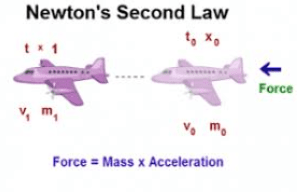Newton’s second law Formula
 Newton’s second law of motion Definition
Newton’s second law of motion Definition
When a force acts on an object, it produces acceleration in the object in its own direction. This acceleration is directly proportional to the magnitude of the applied fore.
Explanation
According to Newton’s first law of motion, force is an agent that changes or tends to change the state of rest or motion of an object.
Newton derived a definite relationship between the force acting on an object. the mass of the object. and the acceleration produced.
Examples of newton’s second law of motion
If we apply the same force on two different objects one heavier and the other lighter we will see that the acceleration produced in the lighter object will be greater than that produced in the heavier object.
Newton’s second law formula
If a force “F” is applied on an object of mass ‘m’ which produces acceleration ‘a’ In the direction of the applied force then the relationship between acceleration and force can be mathematically expressed as
aF………………………………….. (1)(for constant mass)
Similarly for acceleration and mass the relationship can be written as
a ……………………………(2) (for constant force)
Combining equations (1) and (2) we get
A
a
Where K Is constant of proportionality
Or ma = KF (3)
if K=1then
F = ma
UNIT
In SI system, the unit of mass is kg and that of acceleration is ms4, The corresponding unit of force Is
kg m/s2 which is termed as Newton (N).
Thus force acting on a body ¡s, said to be of a Newton ¡f ¡t produces an acceleration of
lms2 in the body of mass 1kg, ¡n the direction of the applied force’.
Related Topics:
- How many types of motion are there in Physics?
- Equations of motion
- What are the three laws of motion?
- Examples of force
- Branches of Physics
- Difference between distance and displacement
- Newton first law
- Newton third law
- Velocity Vs Speed